Process Mining Software Comparison in 2024
According to process mining stats, 93% of business executives want to apply process mining, yet, 79% have never used it. 52% of these leaders consider the need for more process mining tools and expertise as the main challenge behind the low adoption rates.
To close information gaps regarding process mining tools,executives can try these tools that offer free trial options. However, it can still be confusing and time-consuming for enterprises to try all available tools and decide on a tool.
Therefore, In this article, we aim to provide a benchmarking by comparing 3 process mining vendors through their free trials:
- Apromore
- Celonis
- IBM process mining
1. Apromore Process Mining Software
Since 2019, Apromore has offered open-source and commercial process mining solutions. Apromore process mining free trial provides immediate access after signing up. The free trial contains
- Sample event logs files
- Business processes, such as order-to-cash or procure-to-pay
- BPMN models
- Core process mining features such as process discovery and conformance check
- Additional features for KPI monitoring
Figure 1 shows Apromore’s main page, where example event logs from selected processes and simulation examples.
Data upload
Figure 2 shows the types of data the platform supports, ranging from CSV to BPMN models, while uploading data to generate a model or a model to compare against the generated one.
Process discovery
The Process mining solution discovers business processes and displays them as process flows based on resource allocation, employees involved and activities (See Figure 3,4 &5).
Target model creation
To create a target model, users can import the model or create a new one. For instance, in Figure 6, the Apromore process mining enables users to draw a BPMN model as an ideal model. Among three process mining tools, Apromore is the only one that allows drawing a BPMN model instead of uploading it from another platform.
Conformance checking
Users can compare real-life processes against target business processes, such as happy paths and ideal models and run conformance checks against predefined procedures (See Figure 7).
Performance dashboards
Apromore offers BI dashboards to monitor overall process performance (See Figure 8). Also, the tool visualizes deviations detected from conformance checking, such as undesired and missing activities, in the graph (See Figure 9).
Predictive process monitoring
Apromore process mining tool enables users to predict the future outcomes of a running process based on historical data through predictive process monitoring feature (See Figure 10).
Watch the demo to learn more about how to use Apromore:
2. Celonis Process Mining Software
Celonis has offered process mining technology and consultancy on process improvement and automation since 2011. The company has been claimed to be the revenue leader by holding over 60% of the process mining market share.
Data Upload
Celonis process mining’s main page contains common business processes and relevant IT systems and apps: Oracle, SAP and Salesforce (See Figure 11).
When users choose a business process, the tool asks if they want to leverage the data on the Celonis systems or upload a dataset of their own. Data upload can be dragged, dropped, or browsed (See Figure 12).
Celonis process mining software supports any CSV, XES and Google sheets file that is 2 GB or less (See Figure 13). It also allows users to capture data with task mining.
Process Discovery
Celonis process mining software maps process flow and allows users to animate it (See Figure 14). Users can also click on the process step they want to dig into.
Celonis process discovery provides an overview of processes and process variations (See Figures 15 & 16).
Figure 15 shows the most common process variations in the process analysis. Users can regenerate the map for the variant by selecting a variant and view the details for each step and variation by zooming in.
Conformance check
Celonis runs conformance checks by comparing two process flows. Users can select any model they aim to reach and set a time frame to compare. For instance, Figure 17 shows the number of invoices, days sales outstanding, cash discount usage, late payments and perfect invoice percentages between two order-to-cash processes.
Performance dashboards
Celonis process discovery includes key metrics for the selected business process. For example, the dashboards below deliver process insights on cash discount, payment behavior and perfect invoices (See Figure 18 & 19).
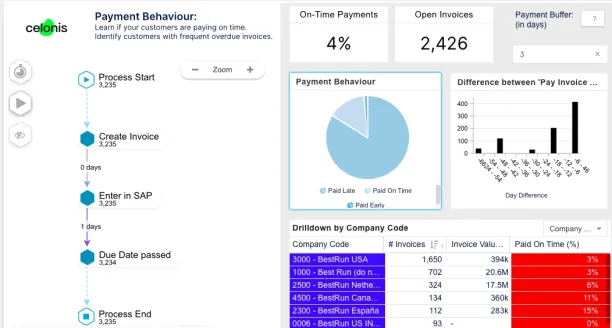
Figure 18: Payment behavior insights
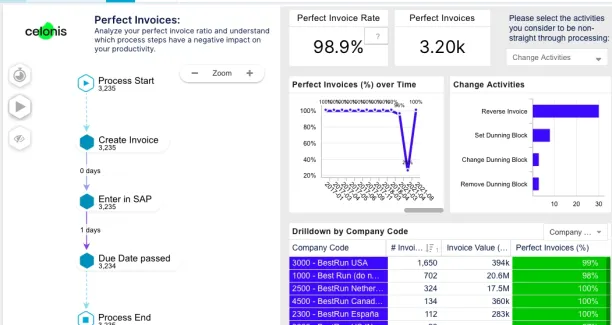
Process analysis
In addition to performance KPIs, process owners can obtain information about other process-related details, such as invoice processing time, multi-hops, SLA compliance and case volume.
Task mining
Celonis task mining can be tested in the free trial upon request. The installation is required for the screen recording solution and is only supported on Windows.
We tested task mining by generating a simple task of invoice preparation and sending it via mail. After allowing the tool, the user behavior was captured and uploaded on the platform cloud, which took slightly longer than expected. The raw data can be displayed in Figure 22.
The tool automatically produced several dashboards on user behavior, such as productivity assessment, frequent actions and hops and time spent per application (See Figures 23 & 24)
Find out more by checking Celonis Demo:
Celonis academy offers a series of short lessons, including a case study to learn how to use Celonis Process Mining.
3. IBM Process Mining Software
IBM has offered process mining solutions since April 2021 as Service, Premise or as a part of IBM Cloud Packs for Automation purchase options.
IBM process mining includes a task mining capability which we proved with the demo but not in the free trial since the free trial does not offer it.
Data upload
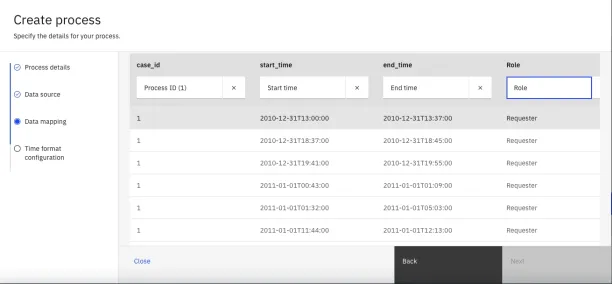
Process discovery
The tool offers an as-is process visualization along with performance measures. It is possible to export as-is process graphs (See Figure 27).
The discovered model is provided as a process map and BPMN graph, as Figure 28 demonstrates.
The map can be animated, and the animation speed, time frame and zoom in & out for each case can be adjusted (See Figure 29).
Besides, users can set certain filters, such as certain activities to highlight, as shown in Figure 30, with warehouse activities.
Users can rearrange the process map activity complexity and relation complexity. When the complexity levels are set to 100, the process map becomes a spaghetti model (See Figure 31).
IBM Process Mining allows users to view activity relationships in terms of cost, rework and frequency, which is important to assess the interrelations across tasks and sub-activities (See Figure 32). When a user aims to change an aspect of a process, the relationship becomes a central question since the change might negatively affect the other activities.
The process mining tool provides process overview by automatically assessing performance and conformance levels for cases (See Figure 33).
Process mining solution allows users to display performance or conformance activities in terms of frequency, average waiting time and service time (Figure 34)
Also, there are search and filter options where users can filter for activities and transitions and add KPIs for critical cases (See Figure 35).
Conformance check
IBM allows process mining users to compare different scenarios and processes with each other. They can compare real data against real data, simulated scenarios or any relevant KPIs such as maverick orders or invoicing. For example, in Figure 36 users can choose pre-RPA and post-RPA options to check whether they achieved the desired ROI from process automation initiative.
Performance dashboards
On process analytics dashboards, process mining users can view details for specific process cases. The KPIs measure frequency, average time and additional graph metrics, such as lead time for the case illustrated (See Figure 37).
These dashboards can also show all deviation details and maverick orders (See Figure 38).
For instance, in the sampling process we analyzed, there were three deviations in cost monitoring (See Figure 39). Notice that IBM automatically delivers the involvement of people in the process and the total cost due to human involvement, helping with automation decisions.
The dashboards can also estimate KPIs for activities and events that can be automated (Figure 40).
Simulation/DTO
Process mining technology can generate a digital twin of an organization (DTO) and IBM is tested to be one of the vendors with such capability. Figure 41 shows the initial settings to create a simulation scenario.
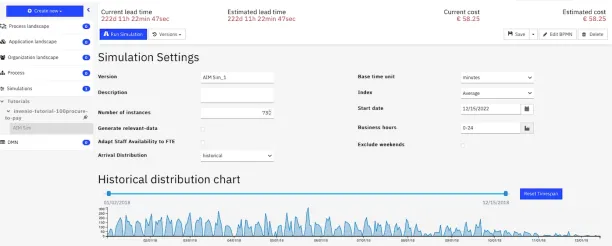
Users can use these simulations to compare against as-is processes, which allows them to measure the impact of any intended change and automation project.
Resource mapping
Process mining solutions are useful to map, monitor and manage resources. IBM simplifies this capability by displaying resource mapping as social net and activity map (Figure 43 & 44). Consequently, business leaders and analysts understand agents that do similar tasks and reallocate the workload accordingly.
Decision & rule mining
Another IBM feature is decision rule mining (Figure 45). Process mining users can easily discover decision rules in their business processes and transfer them to business process automation platform to generate bots that can repeat these rules.
Watch and discover how IBM Process Mining can be combined with other IBM tools to improve and manage business processes:
Also, IBM Process Mining offers free training courses for beginner and intermediate level process mining users.
Note: We know that there are more process mining tools with free trial opportunities, such as
- UiPath Process Mining
- Software AG Aris Process Mining
- Signavio process intelligence
- Lana Process Mining.
We also aim to add these vendors once we complete trying their platforms
Further reading
Explore more on process mining use cases, stats and case studies:
- 44 Use Cases and Applications of Process Mining
- 51 Process mining case studies & project results
- 20 Process Mining Statistics: Market Size & Adoption
Check out comprehensive and constantly updated list of process mining case studies to find out real-life examples for the vendors mentioned above.
If you believe you aim to compare more vendors, leverage our data-driven and comprehensive process mining tools comparison list.
We have prepared a checklist in Google sheets with recommended weights per criteria so you can have a transparent methodology to assess different vendors. Feel free to get it on your business email:
If you need more help, let us know:

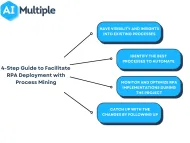
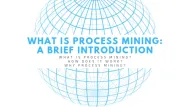
Comments
Your email address will not be published. All fields are required.